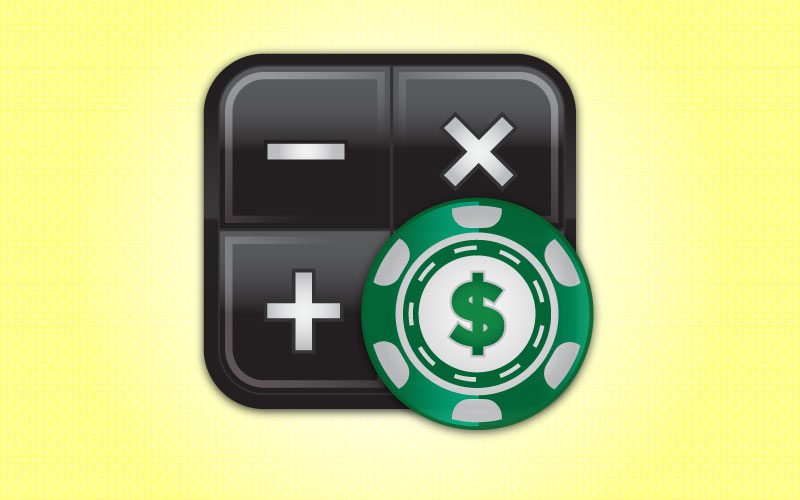Late last year, I had a series of EV Calculation tutorials that offered players a way to do even complex EV calculations with simple addition and multiplication (Part 1, Part 2, Part 3, Part 4, Part 5). Recently, someone posted in the Beginner’s Circle asking about how to do calling calculations. While it seemed like that individual might have just not gone through the entire series and learned the method that I was teaching, I realized that most of the examples I gave were from the perspective of being the aggressor. To this end, I’m going to cover some calling scenarios here in this week’s edition.
Things Can Seem More Complicated Than They Really Are
Situations involving calling are often deceptively simple. Suppose there is a $0.50/1.00 game where the UTG raises to $3, the CO 3-bets to $10, Hero 4-bets to $22 from the button, UTG folds, and CO shoves. If CO had a $75 starting stack, then what is the EV of calling if we expect to have 38 percent equity?
Remember our process: We start by establishing the possible outcomes of calling. In this case, we can say that we either win or we lose. We don’t have to compensate for ties because that’s accounted for with our equity. Next, we need to establish how often each of the possible outcomes will happen. We will win 38 percent of the time and lose 62 percent of the time. Finally, we need to find the profit of each of the possible outcomes. If we win, then we profit the CO’s $75 stack, the $1.50 in blinds, the UTG player’s $3 raise and our original $22 4-bet. If we lose, then we lose our $53 call. Here is the equation we get with this information:
EV of Calling = (chance of winning)(profit of winning) + (chance of losing)(profit of losing)
EV of Calling = (0.38)(101.5) + (0.62)(-55)
EV of Calling = $38.57 – $32.86
EV of Calling = $5.71
As you can see from the above, while the situation itself was somewhat complicated, it all becomes very simple when we break things down according to the process that we have outlined in the previous parts of this series.
If this process isn’t familiar to you, then it’s probably because you haven’t read through the first five parts of the EV Calculations Tutorial series. I suggest that you do so now if you want to get any kind of benefit out of this.
Another Seemingly Complicated Example
Here’s another example that seems more complicated than it really is. We’re on the turn with a nut flush draw with no other outs, and the pot is $18. UTG open shoves for $30 total, the CO player calls $30, and you have the option to call with your $25 stack. What is the EV of calling?
It’s the same process. What are our two possible outcomes of calling? Winning and losing. What are the chances of winning and losing? With nine outs on the turn, we have a 19.57 percent chance of winning and an 80.43 percent chance of losing. What are the profits for each of the possible outcomes? If we win, then we pick up the $18 pot, $25 of UTG’s shove and $25 of the CO’s call for a total of $68. If we lose, then we lose our $25 call for a -$25 profit. That is all of the information that we need to get the expected value of calling.
EV of Calling = (chance of winning)(profit of winning) + (chance of losing)(profit of losing)
EV of Calling = (0.1957)(68) + (0.8043)(-25)
EV of Calling = $13.31 – $20.11
EV of Calling = -$6.80
As you can see, even though this is a much different example than the pre-flop scenario described earlier, the process of finding the EV of the call is very similar. With that having been said, there are more complicated scenarios that we can evaluate with the same general process that we have been describing for this entire series.
Play Across Multiple Streets
This example is a good case of applied implied odds. We’re on the turn heads-up and out of position with a $12 pot and $26 stacks. We check, and Villain bets $8. We have nine clean outs, and we will always win if we hit with no chance of winning if we miss. If we do hit on the river, then we expect to stack our opponent 30 percent of the time. What is the EV of calling? Let’s start by establishing all of our possible outcomes:
- We miss on the river.
- We hit on the river, but we do not get paid off.
- We hit on the river, and we stack our opponent.
Those are the only three outcomes. Now we need the chance of each outcome happening. The chance of missing is 37/46, the chance of hitting and not getting paid off is (9/46)(0.70), and the chance of hitting and getting paid off is (9/46)(0.30). The only piece of information that we need now is the profit that we have from each of the three outcomes. We lose our $8 call when we miss, we win the $12 pot and Villain’s $8 turn bet when we hit and don’t get paid off, and we win the $12 pot with Villain’s $8 turn bet and an additional $18 on the river when we hit and get paid off. All that’s left to do is establish the EV equation and evaluate it:
EV of Calling = EV of Outcome 1 + EV of Outcome 2 + EV of Outcome 3
EV of Calling = (chance of 1)(profit of 1) + (chance of 2)(profit of 2) + (chance of 3)(profit of 3)
EV of Calling = (37/46)(-8) + (9/46)(0.70)(12+8) + (9/46)(0.30)(12+8+18)
EV of Calling = -6.43 + 2.74 + 2.23
EV of Calling = -$1.46
Even in this two-street scenario, there are only three possible outcomes, so the process is fairly straight-forward.
Submit your review | |








